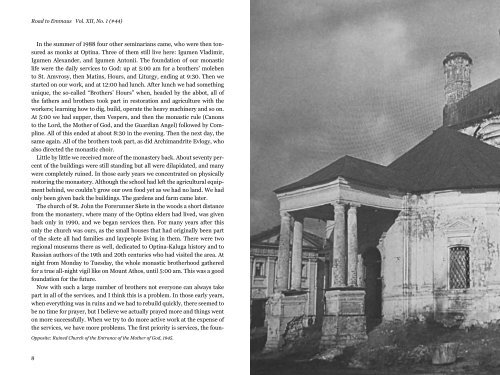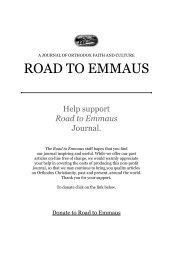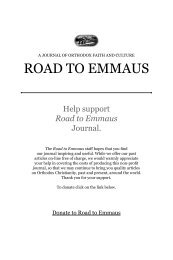RTE No 20 Interior - Road to Emmaus Journal
RTE No 20 Interior - Road to Emmaus Journal
RTE No 20 Interior - Road to Emmaus Journal
Create successful ePaper yourself
Turn your PDF publications into a flip-book with our unique Google optimized e-Paper software.
<strong>Road</strong> <strong>to</strong> <strong>Emmaus</strong> Vol. XII, <strong>No</strong>. 1 (#44)In the summer of 1988 four other seminarians came, who were then <strong>to</strong>nsuredas monks at Optina. Three of them still live here: Igumen Vladimir,Igumen Alexander, and Igumen An<strong>to</strong>nii. The foundation of our monasticlife were the daily services <strong>to</strong> God: up at 5:00 am for a brothers’ moleben<strong>to</strong> St. Amvrosy, then Matins, Hours, and Liturgy, ending at 9:30. Then westarted on our work, and at 12:00 had lunch. After lunch we had somethingunique, the so-called “Brothers’ Hours” when, headed by the abbot, all ofthe fathers and brothers <strong>to</strong>ok part in res<strong>to</strong>ration and agriculture with theworkers; learning how <strong>to</strong> dig, build, operate the heavy machinery and so on.At 5:00 we had supper, then Vespers, and then the monastic rule (Canons<strong>to</strong> the Lord, the Mother of God, and the Guardian Angel) followed by Compline.All of this ended at about 8:30 in the evening. Then the next day, thesame again. All of the brothers <strong>to</strong>ok part, as did Archimandrite Evlogy, whoalso directed the monastic choir.Little by little we received more of the monastery back. About seventy percen<strong>to</strong>f the buildings were still standing but all were dilapidated, and manywere completely ruined. In those early years we concentrated on physicallyres<strong>to</strong>ring the monastery. Although the school had left the agricultural equipmentbehind, we couldn’t grow our own food yet as we had no land. We hadonly been given back the buildings. The gardens and farm came later.The church of St. John the Forerunner Skete in the woods a short distancefrom the monastery, where many of the Optina elders had lived, was givenback only in 1990, and we began services then. For many years after thisonly the church was ours, as the small houses that had originally been par<strong>to</strong>f the skete all had families and laypeople living in them. There were tworegional museums there as well, dedicated <strong>to</strong> Optina-Kaluga his<strong>to</strong>ry and <strong>to</strong>Russian authors of the 19th and <strong>20</strong>th centuries who had visited the area. Atnight from Monday <strong>to</strong> Tuesday, the whole monastic brotherhood gatheredfor a true all-night vigil like on Mount Athos, until 5:00 am. This was a goodfoundation for the future.<strong>No</strong>w with such a large number of brothers not everyone can always takepart in all of the services, and I think this is a problem. In those early years,when everything was in ruins and we had <strong>to</strong> rebuild quickly, there seemed <strong>to</strong>be no time for prayer, but I believe we actually prayed more and things wen<strong>to</strong>n more successfully. When we try <strong>to</strong> do more active work at the expense ofthe services, we have more problems. The first priority is services, the foun-Opposite: Ruined Church of the Entrance of the Mother of God, 1945.8










